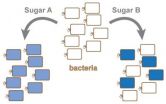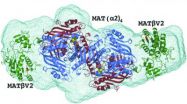Logging and burning cause the loss of 54 million tons of carbon a year in Amazonia
Loss is equivalent to 40 percent of that caused by overall deforestation
2014-07-08
(Press-News.org) A study conducted by scientists in Brazil and the United Kingdom has quantified the impact that selective logging, partial destruction by burning, and fragmentation resulting from the development of pastures and plantations have had on the Amazon rainforest. In combination, these factors could be removing nearly 54 million tons of carbon from the forest each year, introduced into the atmosphere as greenhouse gases. This total represents up to 40% of the carbon loss caused by deforestation in the region.
The study, which was conducted by 10 researchers from 11 institutions in Brazil and the United Kingdom, was published in the May issue of the journal Global Change Biology.
"The impacts of timber extraction, burning and fragmentation have received little notice because all the efforts have been focused on preventing further deforestation. This attitude has resulted in tremendous progress in conserving the Brazilian Amazon, whose deforestation rate fell more than 70% over the past 10 years. However, our study has shown that this other type of degradation is having a severe impact on the forest, with enormous quantities of previously stored carbon being lost into the atmosphere," said Erika Berenguer, researcher from the Lancaster Environment Centre at Lancaster University, in the United Kingdom, first author on the study.
According to Joice Ferreira, researcher at the Brazilian Agricultural Research Corporation (Embrapa Amazônia Oriental) in Belém, state of Pará, and second author on the study, one of the reasons that this degradation has gone unnoticed is that it is difficult to monitor. "Satellite imagery allows much easier detection of areas that are totally deforested," she said.
"Our research combined satellite imagery with field study. We conducted a pixel-by-pixel assessment [each pixel in the image corresponds to an area measuring 900 meters squared (m2)] regarding what has happened over the past 20 years. In the field research, we studied 225 plots (each 3,000 m2) in two large regions in an area measuring 3 million hectares [30,000 square meters], which we used as a model to estimate what occurred in the Amazon as a whole," Ferreira explained.
The satellite images, compared every two years, have enabled researchers to put together an extensive overview of the degradation of the forest along a 20-year timeline. The field research assessed scarring from burning, timber extraction and other disturbances. The combination of the two investigations resulted in the estimate of carbon stock available today.
Two regions were studied in loco: Santarém and Paragominas, in the eastern part of the Amazon region, both under strong degradation pressures. Two hundred twenty-five areas were investigated in these two regions.
"We collected data from more than 70,000 trees and took more than 5,000 samples of soil, dead wood and other components of what is known as carbon stock. It was the largest study conducted to date regarding carbon loss from tropical forests due to selective logging and wildfires," Ferreira said.
According to her, the research included four of the five functionally distinct carbon pools whose study is recommended by the United Nations (UN) Intergovernmental Panel on Climate Change (IPCC): aboveground biomass (live plants), dead organic matter, leaf litter (layer that contains a combination of fragments of leaves, branches and other decomposing organic matter) and soil (up to 30 centimeters (cm) in depth). "The only thing we didn't measure was the carbon stock in the roots," she said.
For comparative purposes, five categories of forest were considered: primary (totally intact) forest; forest affected by logging; forest affected by fires; forest affected by selective logging and fires; and secondary forests (regenerating after complete clearance).
The forests that were disturbed by logging or fire had from 18% to 57% less carbon than primary forests. One area of primary forest ended up having more than 300 tons of carbon per hectare, while areas of forest that had been burned or subjected to timber extraction had, at most, 200 tons per hectare and, on average, less than 100 tons of carbon per hectare.
INFORMATION:
In addition to the researchers already mentioned, the Global Change Biology article was co-authored by Toby Alan Gardner (University of Cambridge and the Stockholm Environment Institute), Carlos Eduardo Cerri and Mariana Durigan (Luis de Queiroz College of Agriculture/USP), Luiz Eduardo Oliveira e Cruz de Aragão (National Institute for Space Research and the University of Exeter), Raimundo Cosme de Oliveira Junior (Embrapa Amazônia Oriental) and Ima Célia Guimarães Vieira (Emílio Goeldi Museum of Pará).
ELSE PRESS RELEASES FROM THIS DATE:
Earthquakes explained? New research shows friction and fracture are closely related
2014-07-08
Overturning conventional wisdom stretching all the way to Leonardo da Vinci, new Hebrew University of Jerusalem research shows that how things break (fracture) and how things slide (friction) are closely interrelated. The breakthrough study marks an important advance in understanding friction and fracture, with implications for describing the mechanics that drive earthquakes.
Over 500 years ago, da Vinci described how rough blocks slide over one another, providing the basis for our understanding of friction to this day. The phenomenon of fracture was always considered ...
Contradictory findings about the effect of the full moon on sleep
2014-07-08
A Swiss research study conducted last year showed that the full moon affects sleep. The findings demonstrated that people average 20 minutes less sleep, take five minutes longer to fall asleep and experience 30 minutes more of REM sleep, during which most dreaming is believed to occur.
Different outcome
Numerous studies through the years have attempted to prove or disprove the hypothesis that lunar phases affect human sleep. But results have been hard to repeat. A group of researchers at the famed Max Planck Institute and elsewhere analyzed data from more than 1,000 ...
Collisions with robots -- without risk of injury
2014-07-08
Everybody has experienced this: You aren't careful for just one moment and suddenly you run into the edge of a table. At first, it hurts. A little later, a bruise starts to appear. What falls into the category of "nothing bad, but aggravating" in the case of a table, takes on a new dimension when the colliding partner is a robot, because such a collision can injure humans seriously. That is why these mechanical assistants usually still work behind protective barriers. Since some applications require humans and robots to work hand-in-hand, though, their cooperation has become ...
Preterm babies more likely to survive in larger newborn care units
2014-07-08
Premature newborns are 32% less likely to die if they are admitted to high volume neonatal units rather than low volume, according to new research.
The study, led by the University of Warwick and published in BMJ Open, analysed data from 165 neonatal units across the UK. It found babies born at less than 33 weeks gestation were 32% less likely to die if they were admitted to high volume units, compared to low volume.
For babies born at less than 27 weeks the effect was greater, with the odds of dying almost halved when they were admitted to high volume units, compared ...
New research finds working memory is the key to early academic achievement
2014-07-08
Working memory in children is linked strongly to reading and academic achievement, a new study from the University of Luxembourg and partner Universities from Brazil* has shown. Moreover, this finding holds true regardless of socio-economic status. This suggests that children with learning difficulties might benefit from teaching methods that prevent working memory overload. The study was published recently in the scientific journal "Frontiers in Psychology".
The study was conducted in Brazil on 106 children between 6 and 8 from a range of social backgrounds, with half ...
Sandalwood scent facilitates wound healing and skin regeneration
2014-07-08
Skin cells possess an olfactory receptor for sandalwood scent, as researchers at the Ruhr-Universität Bochum have discovered. Their data indicate that the cell proliferation increases and wound healing improves if those receptors are activated. This mechanism constitutes a possible starting point for new drugs and cosmetics. The team headed by Dr Daniela Busse and Prof Dr Dr Dr med habil Hanns Hatt from the Department for Cellphysiology published their report in the "Journal of Investigative Dermatology".
The nose is not the only place where olfactory receptors occur
Humans ...
Treatment-resistant hypertension requires proper diagnosis
2014-07-08
High blood pressure—also known as hypertension—is widespread, but treatment often fails. One in five people with hypertension does not respond to therapy. This is frequently due to inadequate diagnosis, as Franz Weber and Manfred Anlauf point out in the current issue of Deutsches Ärzteblatt International (Dtsch Arztebl Int 2014; 111: 425–31).
If a patient's blood pressure is not controlled by treatment, this can be due to a number of reasons. Often it is the medication the patient is on. Some patients may be taking other medicines – in addition to their antihypertensive ...
When faced with some sugars, bacteria can be picky eaters
2014-07-08
Researchers from North Carolina State University and the University of Minnesota have found for the first time that genetically identical strains of bacteria can respond very differently to the presence of sugars and other organic molecules in the environment, with some individual bacteria devouring the sugars and others ignoring it.
"This highlights the complexity of bacterial behaviors and their response to environmental conditions, and how much we still need to learn," says Dr. Chase Beisel, an assistant professor of chemical and biomolecular engineering at NC State ...
A possible pathway for inhibiting liver and colon cancer is found
2014-07-08
A group of scientists from Spain, the UK and the United States has revealed the structure of a protein complex involved in liver and colon cancers. Both of these types of cancer are of significant social and clinical relevance as in 2012 alone, liver cancer was responsible for the second highest mortality rate worldwide, with colon cancer appearing third in the list.
The international team from CIC bioGUNE, the University of Liverpool and the US research centre USC-UCLA has successfully unravelled the mechanism by which two proteins, MATα2 and MATβ, bind to ...
KAIST develops TransWall, a transparent touchable display wall
2014-07-08
Daejeon, Republic of Korea, July 8, 2014 – At a busy shopping mall, shoppers walk by store windows to find attractive items to purchase. Through the windows, shoppers can see the products displayed, but may have a hard time imagining doing something beyond just looking, such as touching the displayed items or communicating with sales assistants inside the store. With TransWall, however, window shopping could become more fun and real than ever before.
Woohun Lee, a professor of Industrial Design at KAIST, and his research team have recently developed TransWall, a two-sided, ...
LAST 30 PRESS RELEASES:
Music: Popular song lyrics have become more negative since 1973
Marine ecology: Killer whales tail dolphins to hunt salmon
ADHD prescriptions on the rise, study finds
How to build a genome
Sharp rise in ADHD stimulant prescriptions in Ontario, research finds
Trends and prevalence of the metabolic syndrome among US adults
Population-level trends in ADHD medication prescribing
Missing piece of myelin disturbs the brain’s rhythm
Insilico Medicine and Taigen achieves license agreement to develop and commercialize AI-driven PHD inhibitor for anemia of Chronic Kidney Disease (CKD)
Exploring dominant endophytic Pleosporales in grasses: New taxonomic insights in the suborder Massarineae
Comparative transcriptomic analysis of human maxillary and mandibular tooth germs reveals discrepancies in gene expression patterns
Scientists detect atmosphere on molten rocky exoplanet - study
Chip-scale magnetometer uses light for high-precision magnetic sensing
Illinois Tech biomedical engineering professor Philip R. Troyk elected as Fellow of the National Academy of Inventors
The National Academy of Inventors welcomes 2025 Class of Fellows
Multi-scale modelling framework predicts mechanical responses of Fe–Cr–Al alloys across composition and processing conditions
Preoperative radiation may improve antitumor immune response in most common form of breast cancer
Breast MRI may be safely omitted from diagnostic workup in certain patients with early-stage, HR-negative breast cancer
Sentinel lymph node biopsy may be safely omitted in some patients with early-stage breast cancer
Rats may seek cannabis to cope with stress
New FAU research strengthens evidence linking alcohol use to cancer
Gut health à la CAR T
Dr. Pengfei Liu receives 2026 O'Donnell Award in Medicine for pioneering advances in genetic diagnostics and rare disease treatment
Dr. Yunsun Nam receives 2026 O'Donnell Award in Biological Sciences for pioneering RNA research transforming gene regulation and cancer therapy
Dr. Bilal Akin wins 2026 O'Donnell Award in Engineering for transformative work in EV energy systems and industrial automation
Dr. Fan Zhang receives 2026 O'Donnell Award in Physical Sciences for groundbreaking discoveries in quantum matter and topological physics
Dr. Yue Hu receives 2026 O'Donnell Award for revolutionizing energy operations with real-time AI and reinforcement learning
Greater risk that the political right falls for conspiracy theories
JMC Publication: Insilico’s AI platforms enable discovery of potent, selective, oral DGKα inhibitor to overcome checkpoint resistance
Targeting collagen signaling boosts drug delivery in pancreatic cancer
[Press-News.org] Logging and burning cause the loss of 54 million tons of carbon a year in AmazoniaLoss is equivalent to 40 percent of that caused by overall deforestation




